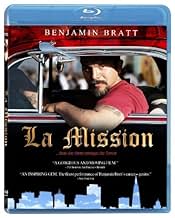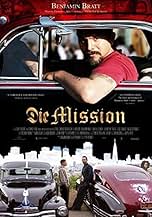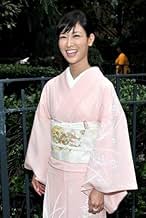Un ex convicto que cría solo a su hijo en un barrio marginado enfrenta una crisis de valores al enterarse de la orientación sexual de su hijo.Un ex convicto que cría solo a su hijo en un barrio marginado enfrenta una crisis de valores al enterarse de la orientación sexual de su hijo.Un ex convicto que cría solo a su hijo en un barrio marginado enfrenta una crisis de valores al enterarse de la orientación sexual de su hijo.
- Premios
- 4 premios ganados y 4 nominaciones en total
Christopher Borgzinner
- Nacho
- (as Chris Borgzinner)
Marco Serralta
- Chuy
- (as Marcos Serralta)
Talisa Soto
- Ana
- (as Talisa Soto Bratt)
Tatiana Maricely
- Nadine
- (as Tatiana Rivas)
- Dirección
- Guionista
- Todo el elenco y el equipo
- Producción, taquilla y más en IMDbPro
Opiniones destacadas
This underrated movie provides an insider's view of the colorful San Francisco's neighborhood known as the "Mission" - a predominantly Latino enclave in San Francisco. Inspired by real characters, it does not present the usual clichés of the ethnic minority drama by avoiding the romanticizing of this environment; it skews the typical down home ethnic wisdom favored by liberal Hollywood and does not become another histrionic sordid ghetto thriller/soap opera.
Supported by an excellent cast, Benjamin Bratt gives an astonishing performance as an intolerant bus driver, a single father who cannot accept his adolescent only son's homosexuality despite the love and pride he feels for him. The violent machismo that have shaped his life is perpetuated by the next generation of disenfranchised youth who prey La Mission.
The neighborhood is presented as an insular world almost anachronistic in 21st century San Francisco. Working class middle age men turn old cars into souped-up low-riding monsters and make fun of soy lattes and recycling, feathered Aztec dancers fill the streets with color and sound as neighbors try to maintain a sense of heritage with their indigenous past, families place flowers and pray where their children have been slain.
The movie transcends its family drama genre allowing the story to evolve at its own pace with a feeling of authenticity and honesty prevailing in every scene. Without providing easy solutions, it centers on a character whose contradictions reflect the world he inhabits. Highly recommended.
Supported by an excellent cast, Benjamin Bratt gives an astonishing performance as an intolerant bus driver, a single father who cannot accept his adolescent only son's homosexuality despite the love and pride he feels for him. The violent machismo that have shaped his life is perpetuated by the next generation of disenfranchised youth who prey La Mission.
The neighborhood is presented as an insular world almost anachronistic in 21st century San Francisco. Working class middle age men turn old cars into souped-up low-riding monsters and make fun of soy lattes and recycling, feathered Aztec dancers fill the streets with color and sound as neighbors try to maintain a sense of heritage with their indigenous past, families place flowers and pray where their children have been slain.
The movie transcends its family drama genre allowing the story to evolve at its own pace with a feeling of authenticity and honesty prevailing in every scene. Without providing easy solutions, it centers on a character whose contradictions reflect the world he inhabits. Highly recommended.
Che has lived in the same apartment in San Francisco's Mission District for 26 years. He has done time but has a garage and restores classic cars, and he drives a bus. He has a teenage son Jes, but we never learn about Jes' mother.
Che is a great guy with a pleasant personality most of the time, and everyone likes him--except Lena, who doesn't want him to work on cars on the sidewalk (did he not have the garage yet?) and just generally seems hard to please. During what free time he has, Che plays pickup basketball with the guys, and he drives one of the many great-looking classic cars in his "low rider" group. He is also restoring a '64 Chevy for Jes as a graduation present.
Jes has a boyfriend Jordan and they go to a loud gay club together. They have a number of photos taken, which Jes leaves lying around. He shouldn't have, because he hasn't told his father. And as cool as Che is, his reaction to his son being gay is not exactly what you would expect. Jes is also bullied by a guy at school who also sees him in the 'hood, and this guy has problems with Che as well.
During the rest of the movie, Che and Jes have to work to resolve their differences. Something does happen that we hope would make everything work out, but it's just not that simple. Meanwhile, Che and Lena started out hating each other, so what do you think will happen with them? Well, not quite what you'd think. Nothing is simple in this movie.
This movie is a quality portrayal of life in a Latino neighborhood, but it is more than that. These people are not merely Mexican. At least some of them, including the bully, are Aztec, and we see the colorful costumes and the dancing of the Aztec culture. We see beautiful art on buildings, and even on that '64 Chevy. Who knew a 60-year-old car could look so good?
Benjamin Bratt gives a remarkable performance with many dimensions. He is not merely this great guy everyone likes. He can be just plain nasty and he can get depressed and withdraw from the world. But overall his is a positive image of Latino culture, because he is genuinely trying to be a good guy.
Another good performance comes from a guy whose name I don't remember. He is a good friend of Che, and he and his wife had a disabled child. This is important in helping Che overcome his prejudices, if indeed he ever does.
And Erika Alexander is worth mentioning as Lena. Jeremy Ray Valdez also does a good job as Jes.
While the movie can be quite serious and controversial, with different types of bigotry, it also has some laughs. One of Che's friends (who is African-American) is able to say "chili chatter" without offending when complaining the others speak Spanish around him when they're in HIS country; they should speak English.
There is some violence and I could tell the language had to be cleaned up a LOT for TV. Amazingly, someone decided the rating should be TV-PG-V. No L, though there are a few words left.
One of the most meaningful parts of the movie is a scene with the low-riders. A new person in the group appears to be warmly welcomed by the neighborhood people. They don't say a word. They just look at the newcomer in a friendly way. Judging from the credits, I would say these are real people from the neighborhood.
It's worth seeing, just in general but also as a Latino-themed movie that is different.
Che is a great guy with a pleasant personality most of the time, and everyone likes him--except Lena, who doesn't want him to work on cars on the sidewalk (did he not have the garage yet?) and just generally seems hard to please. During what free time he has, Che plays pickup basketball with the guys, and he drives one of the many great-looking classic cars in his "low rider" group. He is also restoring a '64 Chevy for Jes as a graduation present.
Jes has a boyfriend Jordan and they go to a loud gay club together. They have a number of photos taken, which Jes leaves lying around. He shouldn't have, because he hasn't told his father. And as cool as Che is, his reaction to his son being gay is not exactly what you would expect. Jes is also bullied by a guy at school who also sees him in the 'hood, and this guy has problems with Che as well.
During the rest of the movie, Che and Jes have to work to resolve their differences. Something does happen that we hope would make everything work out, but it's just not that simple. Meanwhile, Che and Lena started out hating each other, so what do you think will happen with them? Well, not quite what you'd think. Nothing is simple in this movie.
This movie is a quality portrayal of life in a Latino neighborhood, but it is more than that. These people are not merely Mexican. At least some of them, including the bully, are Aztec, and we see the colorful costumes and the dancing of the Aztec culture. We see beautiful art on buildings, and even on that '64 Chevy. Who knew a 60-year-old car could look so good?
Benjamin Bratt gives a remarkable performance with many dimensions. He is not merely this great guy everyone likes. He can be just plain nasty and he can get depressed and withdraw from the world. But overall his is a positive image of Latino culture, because he is genuinely trying to be a good guy.
Another good performance comes from a guy whose name I don't remember. He is a good friend of Che, and he and his wife had a disabled child. This is important in helping Che overcome his prejudices, if indeed he ever does.
And Erika Alexander is worth mentioning as Lena. Jeremy Ray Valdez also does a good job as Jes.
While the movie can be quite serious and controversial, with different types of bigotry, it also has some laughs. One of Che's friends (who is African-American) is able to say "chili chatter" without offending when complaining the others speak Spanish around him when they're in HIS country; they should speak English.
There is some violence and I could tell the language had to be cleaned up a LOT for TV. Amazingly, someone decided the rating should be TV-PG-V. No L, though there are a few words left.
One of the most meaningful parts of the movie is a scene with the low-riders. A new person in the group appears to be warmly welcomed by the neighborhood people. They don't say a word. They just look at the newcomer in a friendly way. Judging from the credits, I would say these are real people from the neighborhood.
It's worth seeing, just in general but also as a Latino-themed movie that is different.
Even in L.A., this powerful film about Latino family culture only ran in a handful of theaters for a fewer number of weeks. Well worth looking for, LA MISSION is one of the most powerful and rewarding films I've seen in years.
Every actor, from unknown to under-rated, is perfectly cast and directed. Leading man Benjamin Bratt is given solid dialog, but in a major scene in which he has no words, his body and soul communicate all that needs to be said and more. The carefully chosen locations and intricately-detailed set design are reasons enough to shut your cell phone off and let it command your undivided attention.
Even the soundtrack which could have gone down a well-traveled "low rider" route takes you to unexpected places -- from indigenous Aztec folk music to India raga; from the 60s to the present. Both the original and adapted musical choices are just as involving as the script and plot. Yet it's not available on a soundtrack CD as of this writing.
Don't want to say more, because the film is best seen "cold" with little inside knowledge. But you will leave the theater (or your home screen) wondering why this well-crafted labor of love is such a well- kept secret.
Woefully overlooked despite solid reviews, it's 2 hours well spent -- and warrants repeated viewing for years to come.
Every actor, from unknown to under-rated, is perfectly cast and directed. Leading man Benjamin Bratt is given solid dialog, but in a major scene in which he has no words, his body and soul communicate all that needs to be said and more. The carefully chosen locations and intricately-detailed set design are reasons enough to shut your cell phone off and let it command your undivided attention.
Even the soundtrack which could have gone down a well-traveled "low rider" route takes you to unexpected places -- from indigenous Aztec folk music to India raga; from the 60s to the present. Both the original and adapted musical choices are just as involving as the script and plot. Yet it's not available on a soundtrack CD as of this writing.
Don't want to say more, because the film is best seen "cold" with little inside knowledge. But you will leave the theater (or your home screen) wondering why this well-crafted labor of love is such a well- kept secret.
Woefully overlooked despite solid reviews, it's 2 hours well spent -- and warrants repeated viewing for years to come.
My family was from the Mission District when it was primarily an Irish neighborhood. Its main claim to fame was it has the nicest weather in San Francisco. I grew up during the transition from Irish to Hispanic, and had a front row seat on the ethnic diversity that took root during the late 1940's/early 1950's. While much has changed since then much has remained the same. Still has great weather and a beautiful park in its midst, right next to Mission High School and Mission Delores. The film perfectly captures the Mission District of today with its hugely Hispanic influence. It is a refreshing change from the yuppie San Francisco we usually see in movies with an emphasis on the Marina, Union Square, and Pacific Heights. The Mission is still where the working class live as it was back when I was growing up. This is a movie about working class values, family values, and machismo, with a San Francisco backdrop. The cinematography is first class with good use of closeups of people, cars, and interesting houses. The movie of course is mainly about the class of Hispanic male culture versus the gay experience in San Francisco, and it pulls that off by presenting a sympathetic view of each culture. That is not easy to do. I enjoyed this movie not so much because it was so well made but because there are so few movies that even attempt to capture a human sized story with a story about a working class neighborhood in a world famous city. This movie was different in a very good way. It was also nice to see a movie about Hispanics not centered either in L.A. or New York. The cast was uniformly excellent. There wasn't a false note in this movie. Kudo's to the Bratt brothers for having the tenacity to make this movie.
This movie is smart, passionate, down to earth, poignant, heartbreaking and heartwarming. Superb acting, scenery, setting and supporting cast.
Benjamin Bratt and Erika Alexander are inspired in starring roles. But the supporting cast is rich with excellent actors. The resultant effect is a true ensemble feeling. Intertwined with the main story - about a man and his high school son who is emerging as a gay man - are many subplots that help paint a richer picture of the barrio and the culture:
There are the low rider cars - colorful and flamboyant. And there is the life of the neighborhood, hanging on the stoops, getting along with the people next door.
This is a must see.
Benjamin Bratt and Erika Alexander are inspired in starring roles. But the supporting cast is rich with excellent actors. The resultant effect is a true ensemble feeling. Intertwined with the main story - about a man and his high school son who is emerging as a gay man - are many subplots that help paint a richer picture of the barrio and the culture:
There are the low rider cars - colorful and flamboyant. And there is the life of the neighborhood, hanging on the stoops, getting along with the people next door.
This is a must see.
¿Sabías que…?
- TriviaTalisa Soto, who plays Ana, and Benjamin Bratt, who plays Che, are married in real life. They met on the set of Blood In, Blood Out (1993) where Rene, played by Jesse Borrego, stars alongside Benjamin Bratt.
- ErroresThe memorial in Che's garage indicates his wife died in 1985. The banners in the graduation scene read "La Mission High School Class of 2009". Since it is very clear Jes was a model student, it is doubtful he would be graduating high school at the age of 24 or higher.
- Citas
Che Rivera: Stay brown.
Kenny: Can't do nothin' but.
- Bandas sonorasMe Rompiste El Corazon
performed by Rene Peña Govea
Music courtesy of Round World Music
Selecciones populares
Inicia sesión para calificar y agrega a la lista de videos para obtener recomendaciones personalizadas
- How long is La Mission?Con tecnología de Alexa
Detalles
Taquilla
- Presupuesto
- USD 3,000,000 (estimado)
- Total en EE. UU. y Canadá
- USD 1,062,941
- Fin de semana de estreno en EE. UU. y Canadá
- USD 49,046
- 11 abr 2010
- Total a nivel mundial
- USD 1,062,941
- Tiempo de ejecución
- 1h 57min(117 min)
- Color
- Mezcla de sonido
Contribuir a esta página
Sugiere una edición o agrega el contenido que falta















